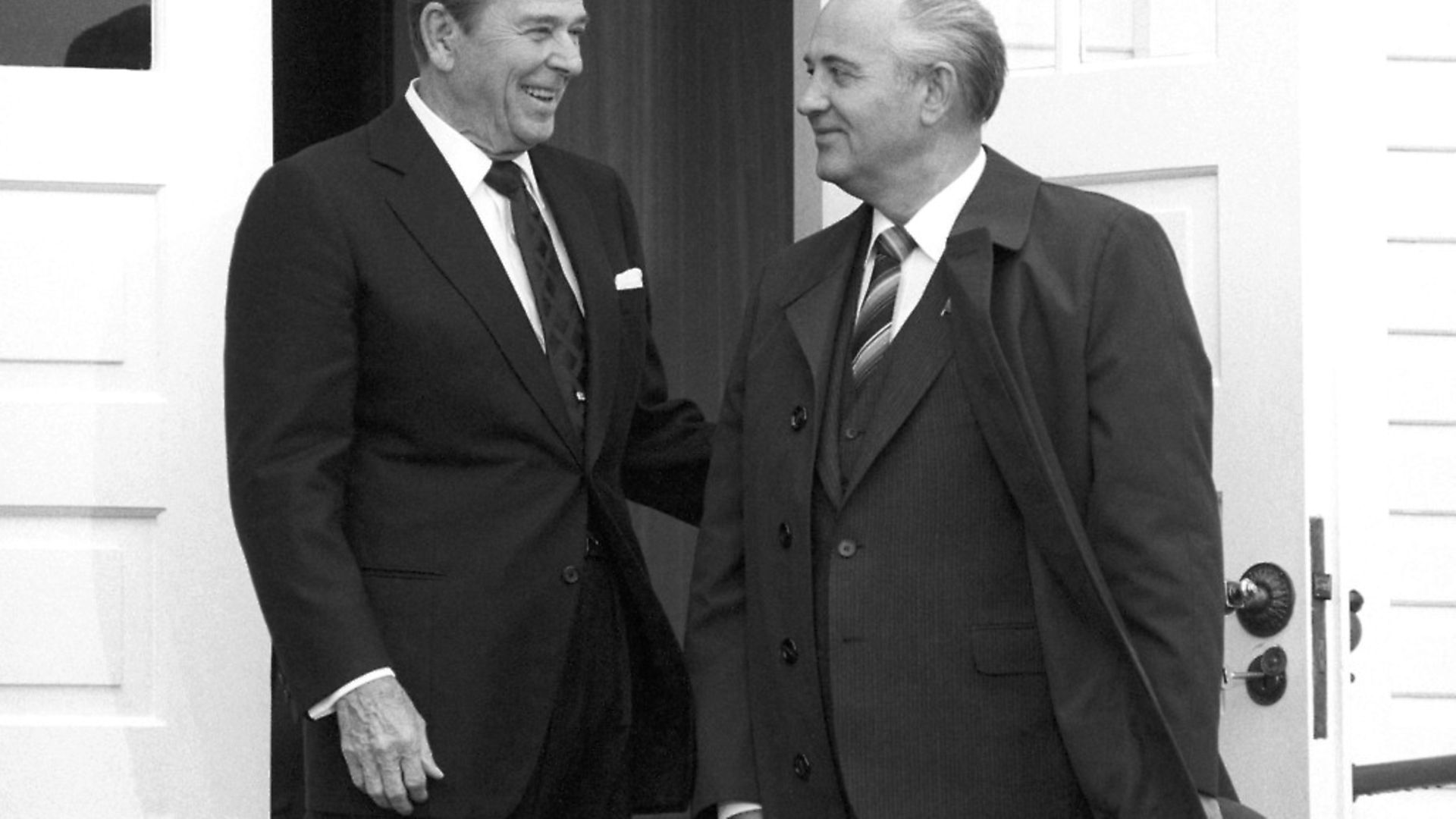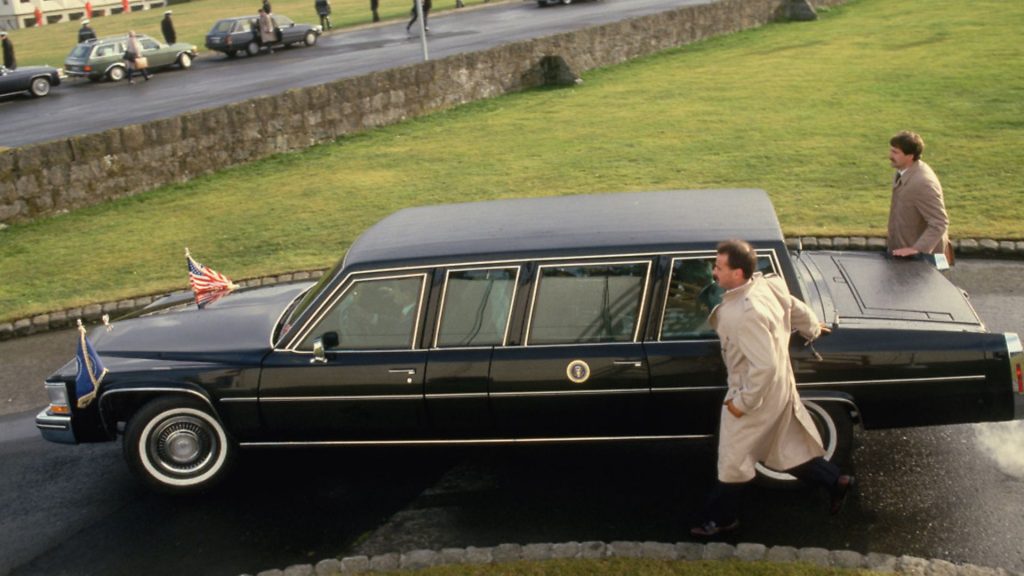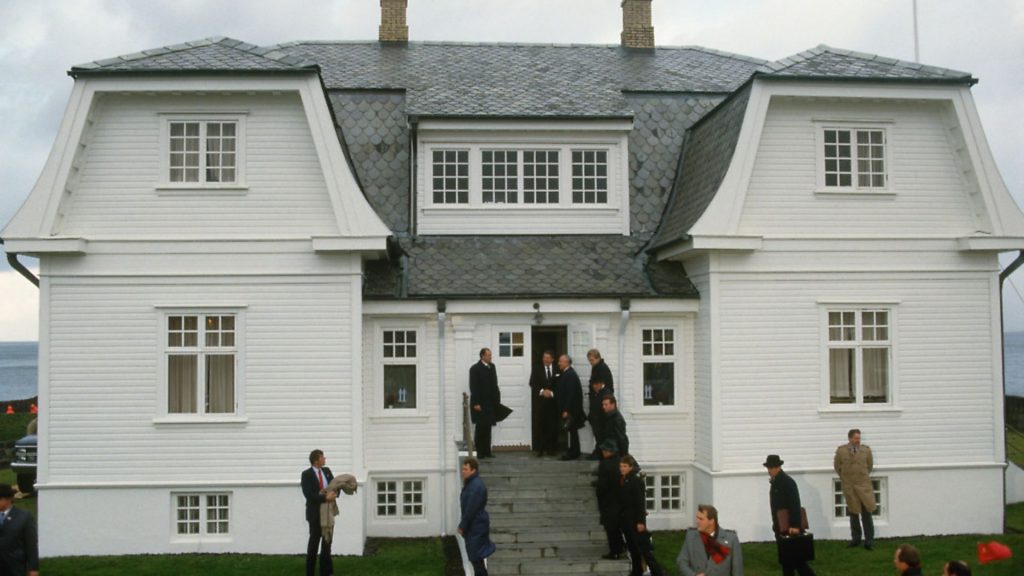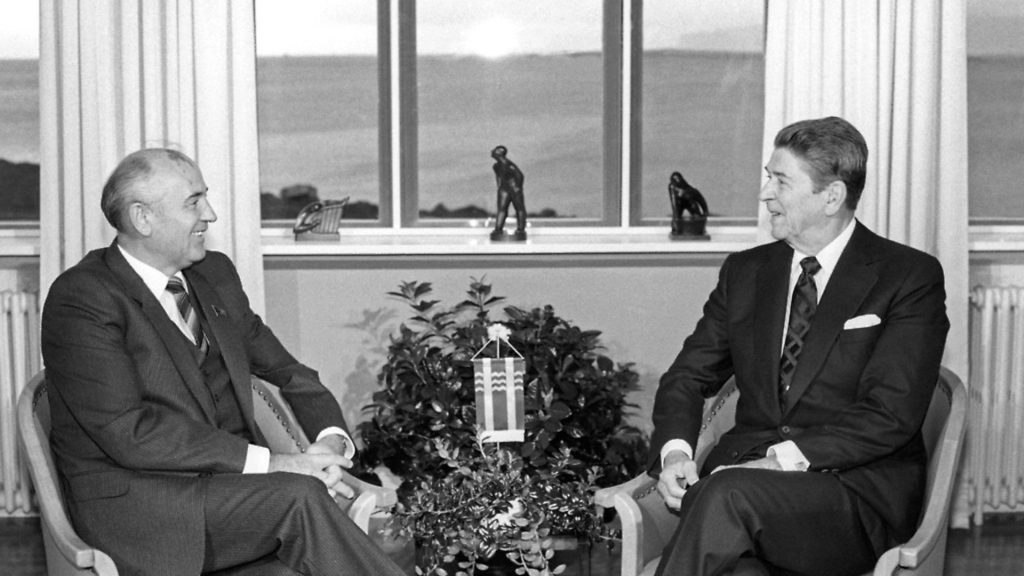
As Trump and Putin try to unpick agreements on nuclear weapons that have helped keep the world safe, IAN WALKER looks back at the moment the world first stepped back from the abyss

The summit held by Ronald Reagan and Mikhail Gorbachev over a weekend in October 1986 at a windswept former British consulate building overlooking Reykjavík’s Faxa Bay was a hastily-arranged affair.
Held over two days, it was intended to be a preliminary get-together to establish the parameters for discussions at later, larger meetings in Washington and Moscow. The main item on the agenda was a suggestion to reduce the nuclear arsenals of both Cold War foes. The parameters to be set were in identifying which weapons might be cut, and by how much.
The summit was hastily arranged because Gorbachev, who had been leader of the USSR for little over a year, was in a hurry. He wanted to cut Soviet military spending and, to do so, needed to out-manoeuvre the Soviet old guard in the politburo – men who were almost all products of the Second World War and the USSR’s desperate struggle against the Nazis. This old guard believed that you could never spend too much on defence. They were men who would cling to the idea of Soviet military might even as their country was falling apart.
And their country was falling apart, hence Gorbachev’s urgency. By the mid-1980s, the USSR was on the edge of being financially broke. Somewhere between 20%-40% of GNP was spent on the military, with the state struggling to fund it with overseas sales of oil, the country’s most valuable natural resource. Desperately flogging off fossil fuel to buy tanks and bombs meant that the Soviets had to increasingly rely on nuclear power. But, tragically, it wasn’t just the USSR’s finances that were broken. Its infrastructure too was strained to the limit. Too many things just didn’t work properly and in April 1986, in Chernobyl, in the northern Ukrainian Soviet Socialist Republic, this mixture of inefficiency, ineptitude and woeful improvisation took the county to the edge of something apocalyptic.

There were lots of reasons why the nuclear disaster at Chernobyl happened, but one reason was that the Soviets had a policy of ‘dual use’ – that something designed for civil use could be quickly adapted to military use. So, for example, tractor factories could be swiftly adapted to produce tanks, if required. The RBMK model reactor at Chernobyl was a dual use design. It had originally been designed in the 1950s to produce plutonium for weapons. In the 1970s it was transferred to civilian use, but it was designed so that its irradiated fuel rods could be quickly removed if the military suddenly needed them. This ease of access meant that the reactor did not have the sort of protective shell that may have minimised the 1986 disaster.
The Soviet military itself was also rotting away from the inside. Much of the country’s defence equipment simply didn’t work very well. Examples are legion (and it was said that the reason why the Soviets produced so many nuclear bombs was that they knew many of them would probably not work). One particular example was very much at the front of Gorbachev’s mind as he flew to Reykjavik because it had happened only a few days earlier. On October 3, 1986, the Soviet submarine K-219 suffered an explosion and fire in one of its nuclear missile hatches. After aborted attempts to save the sub – and its payload of nukes – it sank to the bottom of the North Atlantic (where it remains today).
Gorbachev was clear-sighted about what needed to be done. To survive, the USSR had to change. It had to reduce its military spending and break from the cycle of military escalation. To do this, he had to not only out-manoeuvre the ‘Never Forget Stalingrad’ politburo, but also convince the US president, a right wing Cold War hawk, of his sincerity.
Ronald Reagan was almost two years in to his second term when he flew to Reykjavík. Through his re-election, as through his election, his position on the Cold War was clear: he wanted to end it by defeating the Soviet Union.

As such, he surrounded himself with fellow hawks. One of these was Richard Perle, a key players, if not the unofficial leader, of the neo-conservative core that lay within the US government. This group steered much of US foreign policy in the 1980s (and then later after 9/11). Under Reagan, Perle served as assistant secretary of defense for global strategic affairs, a role primarily concerned with how the US should use and develop its nuclear arsenal.
The Cold War, which intensified after the Soviet invasion of Afghanistan, quickly escalated under Reagan. There had been a series of summits between the US and Soviet leadership – 18 in all – which were designed to limit the proliferation of nuclear weapons, the most famous being SALT (Strategic Arms Limitation Talks).
But under Reagan, the US began to increase its tactical (short and mid-range) nuclear arms capabilities. Cruise missiles were deployed in the UK, Pershing IIs in West Germany. This was America’s biggest peacetime military build-up. The escalation was crowned by the 1983 Nato exercise Able Archer, which was designed to simulate the start of a nuclear conflict.
In the event, the Soviets feared that this massive operation was actually the start of a real assault by the West, and began taking measures to respond. Other than the Cuban Missile Crisis, Able Archer was the closest the world came to nuclear war.
So this was how the sides were stacked up when they met in Reykjavik in autumn 1986, a bellicose USA and a suspicious, wary Russia on the edge of collapse. Looking back, it is hard to see how these two sides could have found any command ground. Yet there was one thing that gave a hint of potential progress.
Reagan and Gorbachev had already met, at a summit in Geneva the year before. And the Russian liked the American. The pair had got on. More importantly, Gorbachev realised there was more to Reagan than his hawkishness. He believed that he could get his rival to support his strategy of scaling down the Cold War.
Reagan’s journey to the Icelandic capital – geographically located midway between the two superpowers – was pretty typical of the man. On Air Force One he didn’t read his briefing notes. Instead, delighted that the crew were serving meatloaf (his favourite), he told folksy anecdotes to his advisors. Because it was not intended to be a major summit, his beloved wife Nancy had stayed at home. He was planning to be back in time for dinner with her 48 hours later. But Reagan and his advisors had misread what was coming.
Reykjavík was a huge deal, and everyone except Reagan had his advisors seemed to understand that. All three major America news channels, along with the new kid in town, CNN, turned up with for rolling 24-hour coverage.
The Soviets practically invaded the place. The Icelandic government had requested that Gorbachev did not arrive during Iceland’s ceremonial opening of parliament. Hamstrung, as ever, by bureaucracy, though, the Russians were unable to change their plans. Gorbachev’s motorcade steamrollered into town, followed by an army of advisors and security, inconveniencing and upstaging everyone. The Soviets even brought a cruise ship to house their people. And Gorbachev’s wife Raisa was also in attendance, as if for a state visit.
But this big entrance stuff by Gorbachev was only half of his game plan. He wanted to make sure that the world was paying very close attention to what he planned to do next – which was no less than to offer to end the Cold War.
To do that he needed to exploit the one thing he had going for him when it came to dealing with Reagan, which was that they liked each other and got on well – though Gorbachev did find Reagan’s folksy anecdotes and habit of repeating the same stories to illustrate a point very irritating. Reagan did both a lot whilst in Reykjavik. According to the book Reagan At Reykjavik, Ken Adelman’s first-hand account of the summit, Reagan’s repetition, in Russian, of the proverb Doveryai, no proveryai (trust but verify) drove Gorbachev up the wall.
But the Geneva conference the year before had given Gorbachev the idea that if he could isolate Reagan from his hawkish advisors and the two of them could sit in a room and talk through how ludicrous this apocalyptic escalation in nuclear weapons was, then they could get somewhere.
The venue chosen for the meeting between the two men was Höfði house. Architecturally, the building was in the Jugendstil style. It had been built for the French consul and had also housed, at various times, the British embassy and the prominent Icelandic poet, Einar Benediktsson. It was grand, slightly austere, and had epic views across the rain-lashed North Atlantic and over Iceland’s back volcanic hills. It was also said to be haunted, perhaps even by the ghosts of Viking warriors who died in a battle defending the land on which the house stood.
This strange building, with it slight Ragnarok vibe, and bleak, elemental views, added to the drama of the meeting, where the two most powerful men on earth were to discuss how to end the apocalyptic logic of nuclear escalation.
Each man brought an entourage of aides and advisers, but they were there to grind out the details in all-night sessions. The main event took place in a conference room, with Gorbachev and Reagan sat around a small rectangular table. There were the usual translators and note-takers in the room and the US secretary of state George Shultz, and the Soviet Foreign Minister Eduard Shevardnadze sat in for some sessions. But this was essentially a one-on-one meeting.
And in the first encounter between the two leaders, Gorbachev came straight out with his proposal – he wanted to get rid of all nukes and he wanted to settle on a plan to do so with the next 48 hours.
Later, the Americans would claim that they were not blindsided by Gorbachev’s bold initiative. Paul Nitze, one of Reagan’s advisors and a staunch believer in the nuclear deterrent, said that the American plan was to cherry pick what they wanted from Gorbachev’s offer – which they knew was coming – and then give nothing in return.
Nitze was one of the co-founders of Team B, a think tank designed to evaluate classified intelligence on the Soviet Union. Team B would argue that the USSR were pursuing a hostile nuclear programme which had be combatted by the US escalating their own capability. His thinking had helped shape the Cold War that Gorbachev was now trying to convince Reagan could be ended.
But the American advisors were blindsided because most didn’t grasp that Gorbachev was sincere. The Soviet leader laid out his plan: the abolition of all strategic nuclear weapons in Europe (those designed to take out military and battlefield targets) and of 50% of tactical nuclear weapons (those designed to take out cities), as well as, by the end of the century, the abolition of all nuclear weapons. In return he wanted the US to drop the Space Defense Initiative (SDI).
Often nicknamed the Star Wars programme, this project was designed to act as a shield against a Soviet nuclear attack. The madness of nuclear proliferation was that it created a situation where US missiles effectively defended the Soviet Union and vice versa because those American missiles guaranteed that the USSR would be destroyed if it ever decided to use its own missiles. The best defence for the Soviets was to never use its expensive arsenal.
The SDI would change the logic behind this Mutually Assured Destruction (MAD). Suddenly those US missiles, instead of acting as a defensive guarantee that the Soviet weapons would always remain in their silos, became purely offensive weapons again. The SDI took ‘mutual’ out of the equation.
Or, rather, it would if it had existed. In 1986, the SDI didn’t really exist as anything much more than a concept. Reagan himself believed that he thought it up. As governor of California, he had visited the North American Air Defense Command (Norad) complex in Colorado. While there, he asked what would happen if there was a nuclear attack. The processes of response were explained to him – a series of orders and instructions, with the end result of annihilation. Nothing would be achieved. Reagan rationalised this as a world where there was a sword, but there was no shield. The SDI was his shield.
Reagan didn’t really think it up. There had been various notions and plans to come up with a system for shooting down incoming nukes since the 1950s. But now, with American technology embracing miniaturisation, systems integration and computerisation (all things so far beyond the USSR – a country that, by the mid-1980s, could barely produce a working car), the plan was feasible and had the full backing of the president.
And the hawks also loved SDI. It gave the US the upper hand and could break the impasse of nuclear escalation. The Soviets could build as many bombs as they wanted, it would make no difference once the US had a shield. But here was Gorbachev offering Reagan another option, another way to break the impasse. All the US had to give up was this vague, untested, undeveloped Star Wars programme.
Why Gorbachev insisted on the dropping of the SDI is not clear. (He would have known that it was hardly off the drawing board.) It may have been a palliative to the Kremlin old guard, to make it look like he wasn’t rolling over. It may have been residual Cold War thinking. It may have been a psychological blindspot – Gorbachev realising just how technically inept the Soviet Union was when compared to its rival. Whatever it was, it derailed the summit.
Reagan clung to Star Wars and would not agree to it being included in the terms of the agreement. Again, the question was why he did this? Why did he take a stand over a technology that hardly existed. It may have been because he believed it was his idea and he was being proprietorial. It may have been he thought it could guarantee peace (he offered to share the technology with the Soviets) or it may have been that he just couldn’t just accept everything Gorbachev asked for and offered – just good old fashioned ego.
Reagan very nearly wavered though. Gorbachev offered a 10 year period in which SDI could only be developed in the laboratory. Reagan went back to his advisors and asked whether this would slow down the development of the project. No-one knew because the technology was in its earliest stages. But then, according to Richard Rhodes in his excellent book Arsenals of Folly, Richard Perle, the most hawkish of all hawks, announced, for reasons best known to himself that yes it would. In doing so he derailed the summit.
The press had been hanging about for 48 hours with little to do other than follow Raisa Gorbachev as she visited Reykjavik’s tourist sites – at one point she visited a sheep farm in the rain. But now they had their story.
It was obvious from the moment Reagan and Gorbachev emerged from their meeting that the story was what the meeting had failed. Reagan, usually upbeat and avuncular, seemed worn out and haggard and showed his age. Gorbachev looked as if was struggling to contain his anger. He knew how close he had come to doing something spectacular and he knew that it was the hawks in the American government who had kept Reagan trapped in that Cold War logic.
But the story does not end there. Everybody realised very quickly how close this summit had come to producing something extraordinary. Cold War thinking was coming to the end of its shelf life. The opportunity that was missed in Reykjavik was taken the following year when Reagan and Gorbachev signed the Intermediate-Range Nuclear Forces (INF) Treaty in Washington.
It is this INF treaty that Trump is currently dismantling, that Putin has been ignoring and which China never signed up to in the first place. What was achieved barely a generation ago, after Reagan and Gorbachev came together in Reykjavik, is now being undone – and undone hastily – by the current crop of world leaders.
Tactical nuclear missiles disappeared from Europe as a result of the Washington treaty and the process of military escalation, one which had been dogging the continent for decades, was suddenly checked. The hawks retreated (only to regroup later as the US searched for new enemies in the Middle East), and the Soviet old guard exited from the world stage.
But all of this was not enough to save the USSR. Something more fundamental had shifted in geopolitics. The ideologies of the left, that had shored up the Cold War, no longer had any purchase. What Chernobyl demonstrated was not just that the Soviet Union was financially ruined, but it just did not work. It was a broken county and Gorbachev could never fix it.
There are many events that can be used to mark the beginning of the end of the Cold War, the Polish Solidarity Movement, Chernobyl, the fall of the Berlin Wall, the collapse of the Soviet Union. But there is also a case to be made for the Reykjavik summit, because it was here in 1986, in this odd-looking house, on this remote North Atlantic shore, where there was a sudden fundamental, psychological shift away from all that idiotic Cold War logic. Gorbachev saw how the endless cycles of escalation could be halted, and in those 48 hours, he showed Reagan – that arch Cold War warrior – the path he too could follow.









